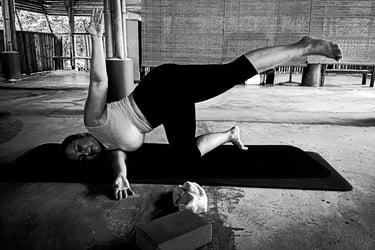Movement Literacy & Vinyasa Krama
What is Movement Literacy ?
Vinyasa Krama is not only a traditional framework—it’s a powerful tool for cultivating movement literacy, the capacity to move with awareness, adaptability, and intelligence across a lifetime.
At its heart, movement literacy isn't about achieving aesthetic perfection or reaching peak performance. It's about knowing how to move well—how to respond, adapt, and recover through different stages of life. And that's precisely what the structure of Vinyasa Krama trains, both in the body and the brain.
The Breath-Movement Loop: A Neurological Bridge
Synchronising movement with breath isn’t just calming—it’s neurologically deep.
Breath sets a rhythm that entrains the nervous system, particularly the vagus nerve, which governs heart rate variability, digestion, and our capacity to down-regulate stress. This rhythmic coupling of inhale and exhale with motion strengthens what's known as sensorimotor integration—the way the brain interprets and coordinates information from muscles, joints, and breath.
In other words, when the breath leads the movement, it creates coherence between the brain and body. Over time, this improves not just how we move, but how we feel, focus, and recover.
Step-by-Step Progression: Rewiring Coordination Patterns
Each intelligently sequenced transition—whether from standing to floor or from one spinal shape to another—builds motor planning, balance, and proprioceptive awareness. These are not fixed traits; they are plastic and trainable.
By gradually increasing complexity, Vinyasa Krama strengthens the brain’s internal map of the body (the body schema) and reinforces efficient movement pathways. This progression respects readiness while building resilience. You're not just learning poses—you’re training the nervous system to respond more skilfully to the demands of life.
Why This Matters: From Back Pain to Prenatal Care
This is why Vinyasa Krama adapts so well across contexts. For someone managing chronic back pain, the progressive structure offers a way to retrain postural habits without overwhelm. For someone pregnant or postpartum, the same principles can gently rebuild pelvic stability and neuromuscular control.
Rather than chasing intensity, this approach cultivates integrity. It invites practitioners to explore range, rhythm, and regulation—on terms their body can safely absorb. And that’s what makes it not just therapeutic, but sustainable.
Returning to the Language of the Body
If Vinyasa Krama is a language, then:
Each body part is a word
Coordinated movement is a sentence
A sequence becomes a story that unfolds through breath and intention
This is where discipline becomes fluency, and fluency becomes freedom.
The true marker of movement literacy isn’t your calendar age, but your ability to adapt.


More Insights
